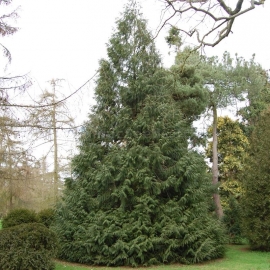




Organic Thua Giant Seeds (Thuja Plicata)
1.14 €
Thua Giant is native to the north western United States and south western Canada, from south eastern Alaska and British Columbia south east through Washington and Oregon to the far north west of California.
-
Organic Thua Giant (Thuja Plicata)
Thua Giant is native to the north western United States and south western Canada, from south eastern Alaska and British Columbia south east through Washington and Oregon to the far north west of California, primarily but not exclusively in coastal forests.
It shares these forests with the other forest giants of the Pacific north west, notably Douglas-Fir, Grand Fir, Sitka Spruce and Western Hemlock.
It has been introduced to many other temperate zones, including western Europe, parts of Australia and also New Zealand. It is a very useful tree for creating a screen from a large hedge to a highly effective large scale windbreak. It is fast growing and much easier and cheaper to produce than the much over used leylandii. It responds well to regular clipping and can be easily maintained as a close cropped hedge.
It grows well in almost all soil types except for shallow dry soils due to its shallow rooting habit. The tree is very shade-tolerant with natural regeneration occurring even in deep shade. The wood and foliage are highly aromatic having a strong fruity smell, like pear-drops or crushed apples. In cold weather the foliage can turn a bronze colour but reverts to its normal healthy green with the new Spring growth.
How to Grow
Seeds of the Thua Giant are relatively easy to germinate and grow. The dormancy within the seed is short and easily broken. This is achieved by a short period of cold stratification in the fridge.
First soaking the seeds in water for 24 hours.
Fully drain away all of the water and place the seeds in a zip-lock freezer bag. Place the seeds in the fridge at around 4 Celsius, it is important that during this period that the seeds do not dry out or are waterlogged otherwise the pre-treatment will be ineffective.
After around 6 weeks under these conditions the seeds are ready to be sown. It is possible for seed to begin germination at these low temperatures before the end of the pre-treatment period. If this happens you can sow the seed immediately.
In general, the seeds will fail to germinate unless treated in this way, simply sowing untreated seeds in compost at room temperature will not break down the dormancy and germination will be disappointing.
Fill your chosen container with a good quality general potting compost. Suitable containers could be plant pots, seed trays or plug trays or even improvised containers with drainage holes. Firm the compost gently and sow the seeds on the surface. If you are sowing in plug trays, sow 2 or 3 seeds per cell.
Cover the seeds with a couple of millimeters of vermiculite or failing that a fine layer of sieved compost.
Follow with a gentle watering and keep them at room temperature. Germination will begin a few weeks from sowing. The seedlings are reasonably robust and trouble free and usually grow to a height of between 3 and 6 cm in the first growing season depending on the sowing date and cultural techniques.
Densely sown seedlings are at risk from fungal diseases such as “damping off” which can cause rapid loss of many seedlings.
Developing seedlings should be fine in full sun, keep them well watered and free of competing weeds. Growth will accelerate in the second and subsequent years and the developing young trees should be re-potted as necessary preferably during the dormant season.
After 3 years they are ready to be planted in their permanent position
